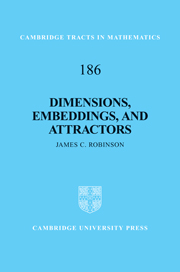Book contents
- Frontmatter
- Contents
- Preface
- Introduction
- PART I FINITE-DIMENSIONAL SETS
- 1 Lebesgue covering dimension
- 2 Hausdorff measure and Hausdorff dimension
- 3 Box-counting dimension
- 4 An embedding theorem for subsets of ℝN in terms of the upper box-counting dimension
- 5 Prevalence, probe spaces, and a crucial inequality
- 6 Embedding sets with dH(X − X) finite
- 7 Thickness exponents
- 8 Embedding sets of finite box-counting dimension
- 9 Assouad dimension
- PART II FINITE-DIMENSIONAL ATTRACTIORS
- Solutions to exercises
- References
- Index
5 - Prevalence, probe spaces, and a crucial inequality
from PART I - FINITE-DIMENSIONAL SETS
Published online by Cambridge University Press: 10 January 2011
- Frontmatter
- Contents
- Preface
- Introduction
- PART I FINITE-DIMENSIONAL SETS
- 1 Lebesgue covering dimension
- 2 Hausdorff measure and Hausdorff dimension
- 3 Box-counting dimension
- 4 An embedding theorem for subsets of ℝN in terms of the upper box-counting dimension
- 5 Prevalence, probe spaces, and a crucial inequality
- 6 Embedding sets with dH(X − X) finite
- 7 Thickness exponents
- 8 Embedding sets of finite box-counting dimension
- 9 Assouad dimension
- PART II FINITE-DIMENSIONAL ATTRACTIORS
- Solutions to exercises
- References
- Index
Summary
The term ‘prevalence’ was coined by Hunt et al. (1992), for a generalisation of the notion of ‘almost every’ that is appropriate for infinite-dimensional spaces. Essentially the same definition was used earlier by Christensen (1973), although for him a set was prevalent if its complement was a Haar null set; we adopt here the more recent and more descriptive terminology. A nice review of the theory of prevalence is given by Ott & Yorke (2005). We only develop the theory here as far as we will need it in what follows; more details can be found in the above papers and in Benyamini & Lindenstrauss (2000, Chapter 6).
Once we have introduced prevalence, we show how the idea can be adapted to treat certain classes of linear maps from infinite-dimensional spaces into finite-dimensional Euclidean spaces (Section 5.2), and then prove a generalisation of the inequality (4.1) that is a key element of the subsequent embedding proofs.
Prevalence
Let V be a normed linear space. First we define what it means for a subset of V to be ‘shy’, the equivalent in this setting of ‘having measure zero’; the complement of a shy set is said to be ‘prevalent’.
- Type
- Chapter
- Information
- Dimensions, Embeddings, and Attractors , pp. 47 - 56Publisher: Cambridge University PressPrint publication year: 2010



